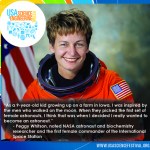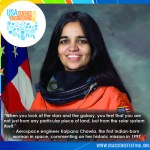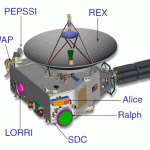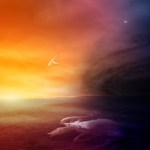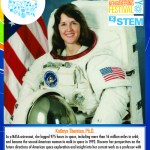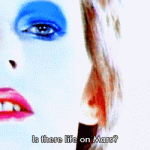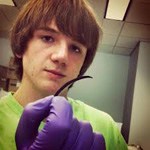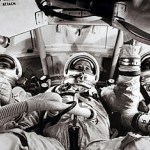NASA
"I am undecided whether or not the Milky Way is but one of countless others all of which form an entire system. Perhaps the light from these infinitely distant galaxies is so faint that we cannot see them." -Johann Lambert
When we look out at the Universe, our view is pretty consistently dominated by the stars within our own galaxy. Although we know that many interesting things lie beyond -- globular clusters, individual galaxies, and rich clusters and superclusters of galaxies -- being in the Milky Way makes it very hard to see beyond it.
Image credit: Richard Payne, of Arizona…
Watch the video below and see if you can see where the warming stops:
(seen at the wonderful APOD site)
Peggy Whitson -- NASA Astronaut and Biochemist
We continue to recognize 50 Years of Women in Space with STEM Role Model Peggy Whitson. Peggy Whitson grew up on a farm in Iowa with big dreams of becoming a NASA Astronaut. She was the first female commander of the International Space Station and a veteran of six space walks. She set records among American Astronauts for spending the most time in space.
Her achievements as a veteran space explorer are well known among the distinguished ranks of NASA astronauts, but learn of her harrowing and life-threatening journey back to Earth after her…
Kalpana Chawla -- Aerospace Engineer, NASA Astronaut
Born in the small town of Karnal, India, she became hooked on flight when she took her first plane ride in a small craft through the local flying club. Kalpana Chawla would later become a certified FAA flight instructor, a talented aerospace engineer, and a NASA astronaut. She was the first Indian American Astronaut and the first Indian-born woman in space. Her promising future ended in 2003 when she died with 6 fellow astronauts aboard the shuttle Columbia over Texas.
Read more to discover how her memory and love of spaceflight are being…
I am thrilled that Comparative Physiologist Dr. Jessica Meir, who was featured in a prior post, has been chosen as a 2013 Astronaut Candidate by NASA! I really enjoyed learning more about her life story in this video and I am looking forward to hearing more about her accomplishments as an Astronaut in the years to come.
Congratulations Dr. Meir and the rest of the 2013 Astronaut Candidates!
Dr. Meir's introduction as a candidate is at 10:30. Listen to her speak about being chosen at 28:50.
Click on this link for an article about Dr. Meir published yesterday in the Boston Globe.
Today's guest blog post is by Featured Science Author Dr. Fred Bortz
Tune in Thursday, June 13th on our Facebook page at 10 am EST to discuss this post with Dr. Bortz!
More than ten years after it was posted at the "Ask Dr. Fred" page "Why Isn't Pluto a Planet Anymore?" remains by far the most popular page at "Dr. Fred's Place" on the web, getting anywhere between 50 and 100 hits on a typical day.
That's a lot of interest in an icy world that is smaller than the moon and so far away that sunlight takes at least 4 hours to reach it! What could possibly be so fascinating…
Over the next 10 years, what research done on bodies within our Solar System (measurements and theory) will be most important for informing our search for life beyond the Earth?
This is the current topic posed as the Single Question on the Future of Astrobiology at the ongoing NASA Astrobiology Institute Roadmap online exercise.
If you want to opine, The Forum is Open
The final session in the online discussion of the NASA Astrobiology Roadmap is today from 4-5 pm eastern.
Go to Astrobiology Future to sign in to the live web chat. Questions and comments will be taken both from call-ins and from written questions.
The online discussion will be moderated by Dr Francis McCubbin from UNM, Dr Sean Raymond from Laboratoire d'Astrophysique de Bordeaux, and yours truly...
The live session will, as with the other Roadmap sessions, be followed by a week long opportunity to input questions, ideas and topics for discussion at The Astrobiology Future Forum.
The four…
Astrobiology Future
The NASA online discussion session on the Astrobiology Roadmap continues this week.
This morning there was a web chat on "Early Evolution of Life and the Biosphere", which is being followed up by an ongoing online discussion on the questions posed and soliciting ideas for priorities in research direction.
The questions being discussed are:
How has the exponential growth in our discovery and understanding of exoplanets impacted the kinds of questions and information we extract from the early Earth record?
Are there problems you think are vital to understanding the early…
I come to praise Kepler, not to bury it...
Kepler!
The Kepler Mission is one of the little NASA spacecraft that so frequently comes along, exceeds all expectations and changes our perspective of the universe.
There is a good Quick History of the transit method and Kepler Mission concept on the website.
Otto Struve noted in his seminal 1952 note that planetary "eclipses" of their parent stars ought to be detectable by photoelectric methods, a proposal that some two decades later was quantified by Rosenblatt, and then explored in detail (including development research) by Borucki and…
The future of Astrobiology research within NASA is being set now.
Next week there are further opportunities for community input.
The online discussion for Solar System Exploration wraps up today!
If you are an active researcher, a student planning on getting into astrobiology, or an interested member of the community, this is your chance to provide input on the direction of research.
This is your future.
Be there, or we will choose for you.
The NASA Astrobiology Roadmap exercise is under way, and will continue over the next two weeks.
NASA Astrobiology
The next two topics will kick off…
What are Origami Nanosat Telescopes? How about Kinetic Inductance Detectors?
More importantly, what should we do with them?
NASA's Astrophysics is doing a Roadmap exercise, with the stated intent to look at science goals, technology and capabilities up to 30 years out!
White papers were solicited a few weeks ago, and about 100 were received and are archived online, about 3/4 on science and 1/4 on technology.
There was originally supposed to be a workshop for presentation of selected white papers, but in the world of sequestration that was not feasible, so instead there was a two day online…
It is critically important that the community participate in the current ongoing discussion for the NASA roadmaps. Particularly if you are an early career researcher. This is your opportunity to make the case for what you think is interesting and important.
NASA Astrobiology
NASA is going through a series of Roadmap exercises by the different directorates, trying to set medium and long term policy for science goals, technology development and capabilities.
The NASA Astrobiology Program is doing a rolling series of Roadmap input sessions for four themes for Astrobiology.
Each theme kicks…
James Hansen, author of "Storms of My Grandchildren: The Truth About The Coming Climate Catastrophe and Our Last Chance to Save Humanity", recently announced his retirement from his position as director of NASA's Goddard Institute for Space Studies. My friend John Abraham write's about Hansen's retirement in his inaugural* post in the new blog "Climate Consensus - The 97%" ...
What does this mean for climate science and the future of the Earth? It is impossible to know now but instead of looking forward, I want to shine a light on what Jim has done for climate science, what he signifies to…
"For I dipped into the Future,
far as human eye could see;
saw the vision of the world,
and all the wonder that would be." -Alfred, Lord Tennyson
This weekend, the Sun is shining here in Portland, as we've gotten our first annual spell of warm, sunny days recently. It's got me thinking of the approaching summer, and one of my favorite music festivals that's coming up. One of the great groups I'm looking forward to is Keller and the Keels, who have an unparalleled penchant for amazing bluegrass mashups, such as their rendition of two very different songs by Beck/The Grateful Dead artistically…
The USA Science & Engineering Festival is thrilled to introduce our elite group of X-STEM and Nifty Fifty Speakers for the 3rd Festival! In today's blog we feature Physicist and former NASA Astronaut Dr. Kathryn Thornton!
We are excited to announce that Dr. Kathryn Thornton will serve as both an X-STEM and Nifty Fifty Speaker for the Festival! Selected in 1984 by NASA as an astronaut candidate, Kathryn Thornton would go on to serve 12 notable years with NASA's Johnson Space Center in Houston -- a career which would see her become the second American woman to walk in space, in addition to…
Answers on a single sheet double spaced 12 pt font, by monday, please, including figures.
The NASA Advisory Council, subcommittee on Astrophysics, has started a Roadmap Exercise.
The roadmap exercise was called for at the February 2013 meeting.
The roadmap is intended to:
Articulate NASA’s astrophysics vision looking out 30 years
Science-based -> identify key science investigations and challenges for the future
Identify notional missions & technologies needed to enable the science
Developed by a task force of the APS (AstroPhysics Subcommittee)
Include community input, including Town…
You certainly didn't hear it here first: today NASA, at a press briefing, announced that minerals analyzed by the Curiosity rover indicate that life might, in the galactic past, have survived on Mars. The rover's been poking around an ancient network of stream channels descending from the rim of Gale crater since September of last year; now, after drilling into the sedimentary bedrock nearby, it's hit on a treasure trove of life-supporting minerals: carbon, oxygen, hydrogen, phosphorus, sulfur, and nitrogen. These mineral findings are really just icing on the cake, as the geological…
TONIGHT- special guests of the First Lady at the State of the Union include USA Science & Engineering Festival X-STEM speaker Bobak Ferdowsi and Nifty Fifty Speaker Jack Andraka!
Bobak Ferdowsi- referred to as NASA's "Mohawk Guy" is a flight director at NASA's Jet Propulsion Laboratory. In addition to his inspiring day-to-day work on the Mars Curiosity mission, he volunteers as a FIRST robotics mentor to get more boys and girls excited about STEM education. We are thrilled for Bobak to participate in our Extreme STEM Symposium! Read his full biography here.
Jack…
I only barely remember the disaster. It was on this day, but in 1967. In recent years, I've wondered why my memory of the death of Gus Grissom, Ed White, and Roger Chaffee in the Apollo 1 space craft is so vague. I have memories of earlier space activities, but most of those memories are really memories of reading about things in books and magazines, and playing "astronaut" more or less constantly. I had limited access to a TV and TV coverage of every detail of life everywhere all the time had not been invented yet. But really, the main reason I only barely remember the event despite my…

